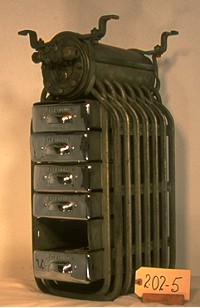Refrigerating and Air Conditioning Evaporators – Commercial
Six tray, ice maker evaporator with low-side float, using an early form of modular construction, in tinned copper tube and brake formed copper sheet. Cooling unit with shiny tinned copper ice cube trays with gleaming polished chrome tray pulls, for large, commercial, ice maker, cabinet refrigerator, similar to the smaller items #022, #023, #024, Of the genre of the first commercial, North American ice making machine, Frigidaire, 1926.
Features:
The early form of modular construction employed allowed the manufacturer to “grow” their evaporators using standard off the shelf components, with relatively predictable performance. The ice cube trays are believed to have been re-tinned and the fronts re-chromed, as part of the refurbishing of the icemaker in T. H. Oliver’s repair shop in Aurora Ontario prior to re application in the 1950’s.
Technical Significance:
See background notes on technological significance of early mechanical cooling units (evaporator), THOC-HVACR inventory item 011.This specimen is representative of the proliferation of models and sizes of low-side float operated evaporators of the period, largely by Kelvinator and Figidaire, as they attempted to stretch this ice making technology to its limit. Dinosaur like, costly, complicated and trouble prone by comparison with the evaporator technologies that would shortly follow, this genre would largely disappear from manufacture’s catalogues by the early 1930’s, although would be operational in the field until after WWII – requiring repair shops to rebuild an calibrate floats and needle seats.
To contrast the weight, size, seeming complexity, as well as materials and manufacturing costs with the technology reflected in inventory items 015 to 021 is instructive. The classic process of progressive simplification in technological innovation and change is well exemplified.
None-the-less this large, modular designed icemaker, “grown” using the same flooded evaporator technology as shown in #024. for example, feed the seemingly endless and ever growing North American market for iced beverages, deserts and product cooling of all sorts . This value set, a distinguishing mark of the North American culture of the times was not to be found to the same extent in urban European setting of the same period.
The stage had been set and the market established for the design and development of the automatic ice cube-making machine, to appear on the market in Canada by the early 1950’s. Icemakers of the general design shown here would prevail up to that time and beyond..
Industrial Significance:
With complex, demanding construction, the evaporator would make many demands on manufacturing and materials engineering in the early years of the 20th century.


